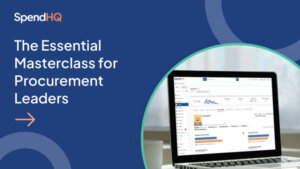Procurement teams have come a long way over the last 20 years. What originally began as purchasing has evolved into a critical business function that offers the potential for greater agility, enhanced efficiency, and improved quality. Beyond that, Procurement plays a pivotal role in the overall savings potential of a business.
A 2021 survey from Ardent Partners cites a change in CPO focus from proactive initiatives back to prioritizing cash management, increasing savings, and improving supply chain visibility. With these goals in mind, Procurement has an opportunity to provide holistic gains for the organization while also helping reduce risks and overall business costs. If Procurement truly wants to demonstrate its value, you need to properly measure its performance and track how it is contributing to business profitability.
What Is Procurement Performance Management?
Performance management is an approach where organizations measure areas of value to determine how Procurement is contributing to the business. This involves an ongoing process of measuring the efficiency and spend of procurement teams to increase visibility and enhance the value of Procurement within an organization.
By identifying these key areas and focusing on improving processes and procedures while also reducing risk and cost, Procurement is able to help meet the larger business goals and develop stronger relationships with key stakeholders.
3 Steps to Enabling Recognition for Procurement Teams
The contribution of procurement teams often does not get fully recognized within a business. Without clear reporting and the buy in from other stakeholders, it’s difficult to get the visibility needed to give credit to the right team. As a result, procurement teams consistently struggle with validating their worth. If Procurement truly wants to show Finance the savings it is achieving and illustrate how its value adds contribute to the business, procurement leaders need to begin by defining clear answers to the following questions:
What are you trying to achieve?
It’s important to remember that, as a general rule, Finance does not expect Procurement to calculate the numbers on the P&L sheet. Regardless, Procurement can show its value by regularly communicating with Finance so that everyone understands what the ultimate goals are.
What does Finance expect to see?
The only true way to determine what Finance wants to see and how they will identify value involves stronger alignment and collaboration between the two teams. Finance and Procurement need to work together to identify what needs to be reported. This frees up Procurement to be an active partner with their business units to drive collaborative change, leaving the role of managing numbers and policy to the Finance or Cost Control Departments.
How does Procurement ensure Finance recognizes all savings?
In order for Procurement to truly align with Finance, it’s important that both teams work together to develop a savings policy and determine how you will measure gains. Procurement will be positioned to provide more value when they understand the expected outcomes.
Additionally, the two teams need to collaborate to define a process to determine a common baseline. They will also set up a check and balances system, where each department validates the success of the other.
This baseline with Finance may provide various types of benefits for the organization, including:
- Impact to P&L sheet in terms of cost savings
- Identification of cost avoidance opportunities
- Mitigation against inflation
- Demand management
In addition, developing a baseline helps to inform a set of rules that will allow the organization to calculate Procurement’s KPIs. The rules should include how you will actually calculate the baseline and include metrics such as historic pricing, mean/low RFP, and budget line items.
Best Practices for Measuring Procurement Performance
For organizations to truly see where they are gaining value, there are a few best practices to keep in mind.
Keep your savings policy simple. Simply put, your savings should cover 80% of cases. The remaining 20% will be adjusted based on a case-by-case evaluation with Finance.
Don’t forget to include cost avoidance. Finance can get stuck on the number that indicates savings, but there’s a difference between soft savings and hard savings. Finance tends to look mostly at hard savings, the number that lands on the P&L sheet. But avoiding costs is another way to save that is not often calculated. Be realistic about how you calculate this number. If you can easily defend it, then it likely qualifies as a cost avoidance metric.
- Develop a structured process to execute your Performance Management plan
- Establish your targets alongside Finance
- Execute the sourcing project
- Measure the gains
- Validate it with Finance and other key stakeholders
Your organization can undertake the same basic process repeatedly. As the process matures and you identify specific criteria that need refining or areas of success, Finance can flag a contribution as reusable so that it can be allocated to the appropriate budget source. When this process is executed correctly, it will create an incentive for the business to regularly engage with Procurement and recognize them as a critical business function.
SpendHQ has a valuable approach that offers significant value to any business. Remember to work closely with Finance, report on all value adds, and clearly identify your metrics.
Want to learn more about how you can get started managing procurement performance? Click below to download our comprehensive guide!
Download the eBook

